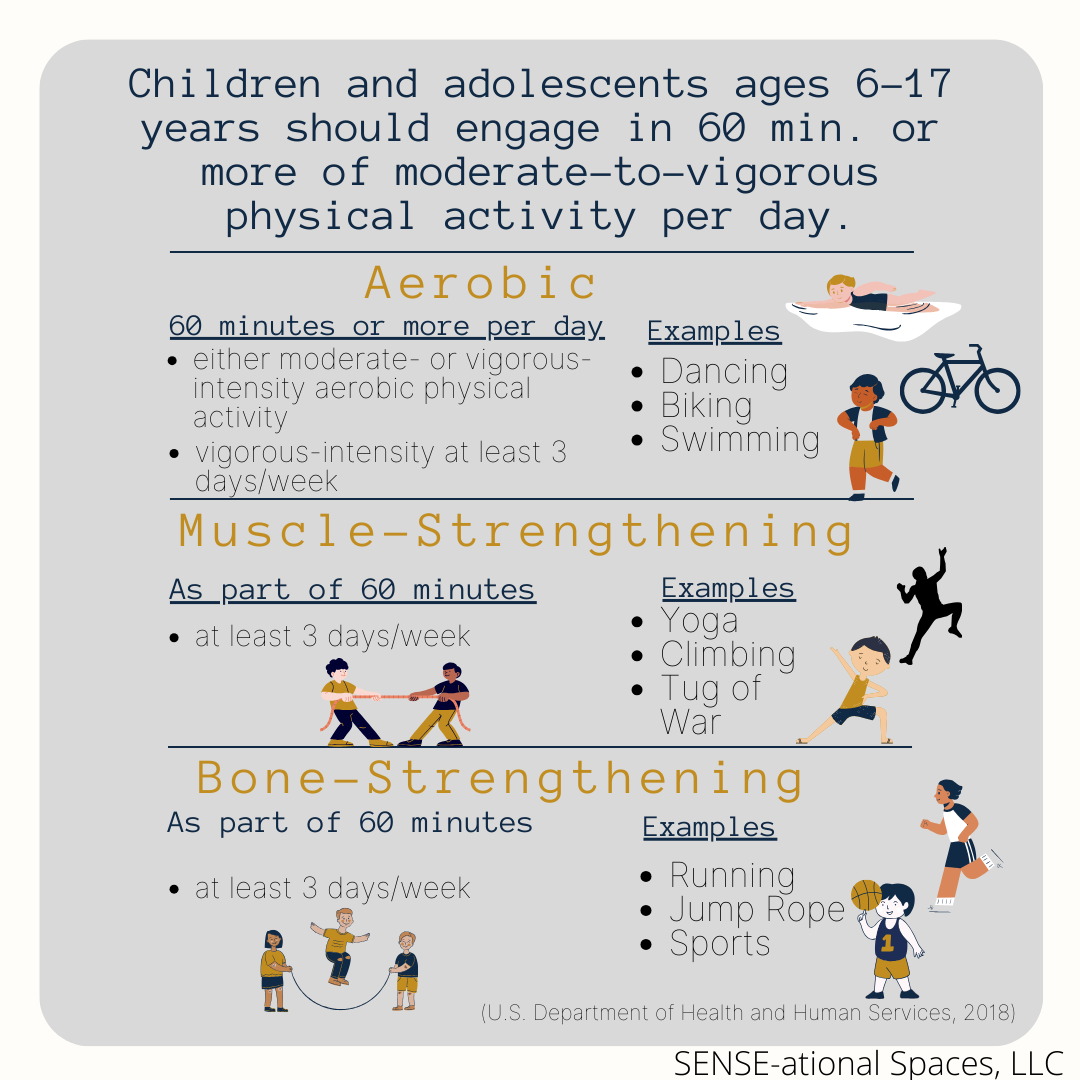Sensory Processing Disorder & Exercise: Staying Physically Active
The Importance of Physical Activity
As we hear time and time again, physical activity is important to incorporate into our daily schedule. In fact, it is something that many Occupational Therapists work on with their clients regularly to “improve or maintain their health and decrease their risk of health episodes” (American Occupational Therapy Association, 2020). While many individuals are aware of the physical activity recommendations for adults, few are aware of the physical activity recommendations for children.
A Reminder: What is Sensory Processing Disorder?
Sensory processing disorder, commonly called SPD, is a condition where the brain struggles to register and respond to the sensations the body is receiving (Brennan, 2023). Oftentimes this results in an oversensitivity to common sensations however, it may also cause under-sensitivity or even a mixture of both. Oversensitive children will tend to avoid the sensation that is causing them stress, such as loud noises, a touch from another person, or even the texture of a certain food. Some individuals will have more noticeable reactions such as screaming, crying, gagging, etc. Under-sensitivity is usually less noticeable to the naked eye, with most people simply unresponsive to sensations around them, even something like a hot stove. Children experiencing under-sensitivity will often seek out sensations. Sensory processing disorder can affect the way children participate in physical activity or exercise. It has been found that the higher a child's tactile sensitivity (touch, pressure, temperature, pain) the higher the intensity of their physical activity participation (Ismael et al., 2018). In other words, the more intense a child can feel something, like the texture of a squishy ball, the more likely they are to engage in more active sports. On the other hand, the higher the child's taste and smell sensitivity, the lower the intensity of their physical activity participation. Additionally, those struggling with proprioception (knowing where your body parts are) and vestibular (knowing where your body is in space) sense challenges will more likely struggle with motor skills. These children may avoid equipment where their bodies are moving throughout space, like swings, teeter-totter, or activities where their body moves more throughout space, like gymnastics.
What Can SPD Look Like During Physical Activity?
Child seems clumsy or is bumping into things
Child doesn’t seem to know their own strength- for example, slamming a door rather than closing it
Avoiding certain activities that most other kids enjoy- like the playground
Preferring independent play over group play
Body looks ‘out of control’- fidgeting movements or ‘flailing’
Constantly moving their body
Not only can these activities allow your child to stay physically active, but some can also help reduce their sensitivity to their surroundings, and movement while being active. The physical activity that seems to help the most with sensory seeking (when a child is actively looking for sensory input) and other sensory sensitivities is heavy work. This is where a child pushes or pulls against resistance. This activity is a lot of effort and is great for calming and orienting the body in the environment. While at times it can be challenging to motivate your children to exercise, it is important for both their physical and sensory health. One way to incorporate this into their routine is by designating a certain time for it every day. Perhaps when they get home from school they have an hour of active time before doing another preferred activity. Maybe if they’re early risers they can be active before getting ready for school. Find a designated time that works best for them and for you. Another way to ensure their participation is by engaging in these activities with them. If you enjoy running, try doing it with your child. If you prefer dancing, have ‘dance parties’ at home. If your child sees you being active, they are more likely to want to be active themselves. By participating in these activities with them, you never know the positive impact you may see!
References
American Occupational Therapy Association. (2020). Occupational therapy practice framework: Domain and process (4th ed.). American Journal of Occupational Therapy, 74(Suppl. 2), 7412410010. https://doi.org/10.5014/ajot.2020.74S2001
Brennan, D. (2023, March 14). Sensory processing disorder. WebMD. https://www.webmd.com/children/sensory-processing-disorder
Ismael, N. , Lawson, L. M. & Hartwell, J. (2018). Relationship between sensory processing and participation in daily occupations for children with Autism Spectrum Disorder: A systematic review of studies that used Dunn's Sensory Processing Framework. American Journal of Occupational Therapy, 72 (3), 72032050301-72032050309. doi: 10.5014/ajot.2018.024075.
U.S. Department of Health and Human Services. (2018). Physical Activity Guidelines for Americans, 2nd edition. Retrieved from https://health.gov/paguidelines/second-edition/pdf/Physical_Activity_Guidelines_2nd_edition.pdf



